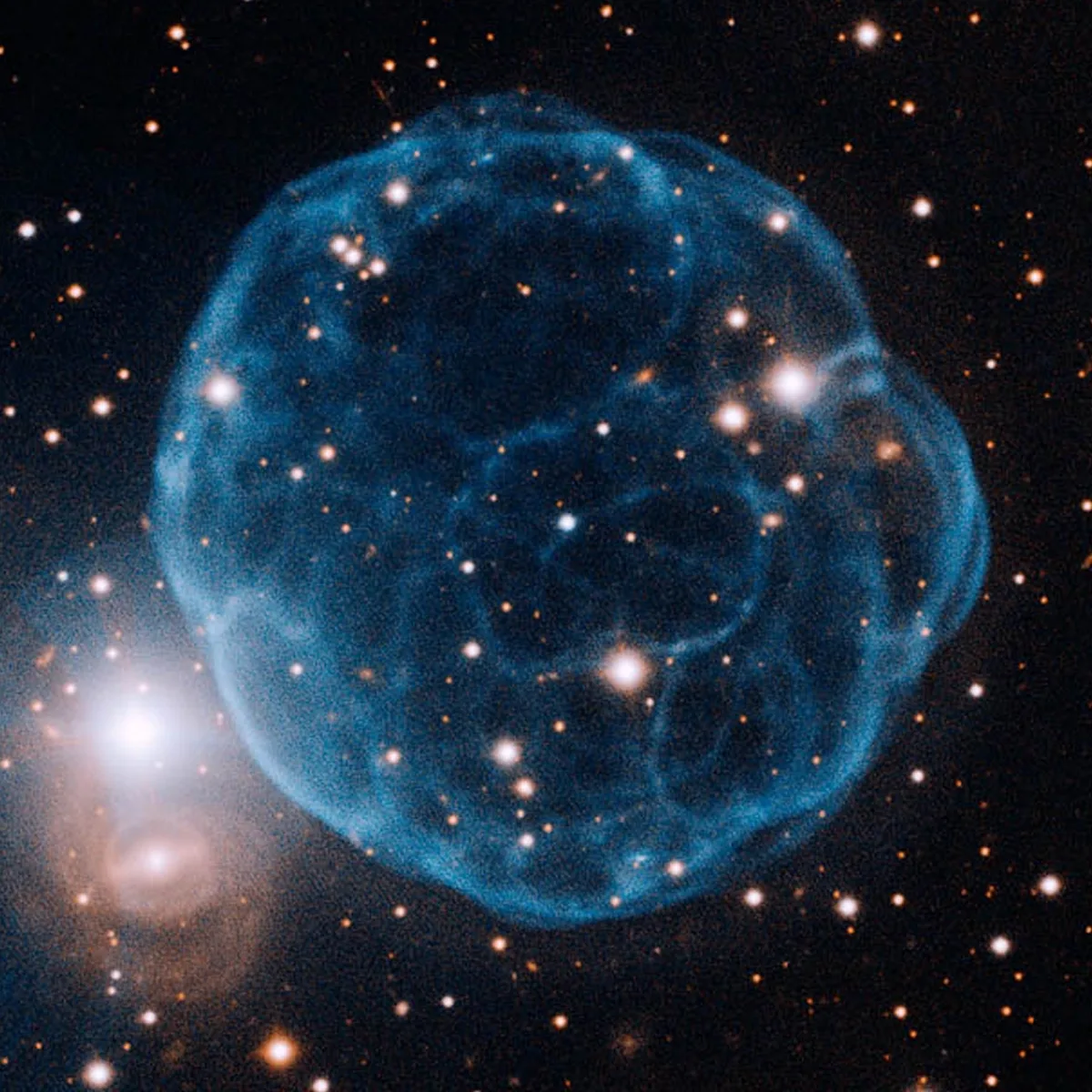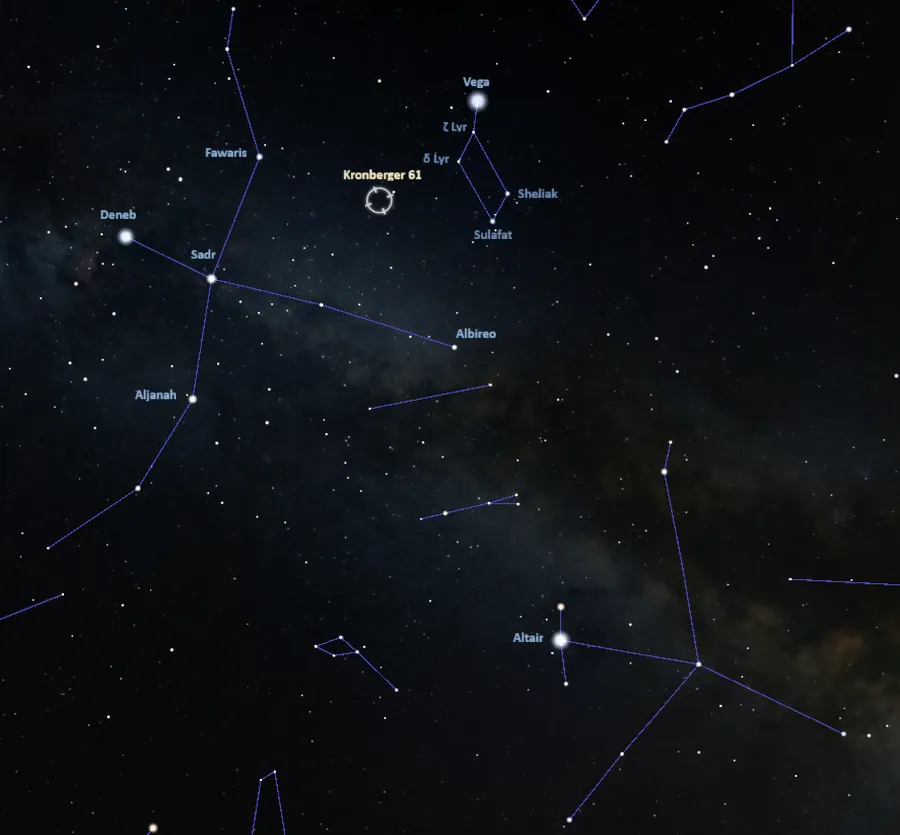The Soccer Ball Nebula (Kronberger 61) is a planetary nebula located approximately 13,000 light-years away in the northern constellation Cygnus (the Swan). With an apparent magnitude of 18.416, it cannot be observed in amateur telescopes. The nebula was discovered in 2011.
The Soccer Ball Nebula is roughly spherical in shape but has a filamentary structure. The nebula’s light comes mainly from the emission of ionized oxygen (O III). Like all planetary nebulae, it formed when an aging red giant star reached the late stages of its life cycle and expelled its outer layers into space. The expanding clouds of expelled gas are ionized by the intense light of the central stellar remnant.
The central star of Kronenberg 61, catalogued as KIC 3231337, is a hydrogen-poor PG 1159 star. PG 1159 stars are hot pre-degenerate stars in the evolutionary phase between being the central stars of planetary nebulae and becoming hot white dwarfs. These are exceptionally hot stars, with effective temperatures in the range between 75,000 K and 200,000 K.

Gemini Observatory image of Kronberger 61 showing the ionized shell of expelled gas resembling a soccer ball. The light of the nebula is primarily due to ionized oxygen (oxygen-III) emission and its central star can be seen as the slightly bluer star very close to the center of the nebula. The field of view is 2.2 x 3.4 arcminutes with north up (rotated 22 degrees west of north). Image processing by Travis Rector, University of Alaska Anchorage. A color composite image, it consists of two narrow-band images (O-III and Hydrogen-alpha with three, 500-second integrations each) obtained with the Gemini Multi-Object Spectrograph (GMOS) on the Gemini North telescope on Mauna Kea in Hawaii. Below the bright star at left is a barred spiral galaxy in the distant background, careful inspection will reveal several additional distant galaxies in the image. Image credit: Gemini Observatory/AURA (CC BY 4.0)
A 2023 study led by Howard E. Bond, Department of Astronomy and Astrophysics, Pennsylvania State University, reported an effective temperature of 170,000 K for the central star of the Soccer Ball Nebula. In images of the nebula, the progenitor star is the bluish star that appears near the nebula’s centre.
KIC 3231337 was observed with the National Optical Astronomy Observatory’s (NOAO) Mayall 4m telescope on Kitt Peak in June 2012. Based on the obtained data, an international team of astronomers led by Orsola de Marco, Department of Physics and Astronomy, Macquarie University, Sydney, Australia, found a lack of neutral helium (He I) lines in the star’s spectrum in 2015. The findings indicate a surface temperature of over 70,000 K. The researchers also found the presence of ionized nitrogen (N V) absorption lines, which constrains the temperature to less than 115,000 K.
The team detected peaks in the star’s light curve that occur every 2 – 12 days. At the time, this type of variability was unprecedented. While astronomers suspect that the variations may be caused by wind outbursts possibly triggered by an unseen companion in an eccentric orbit, there is no definitive explanation for the star’s light behaviour. The star’s brightness was reported to vary with an amplitude of 0.08 – 0.14 mag.
The astronomers obtained a radius of only 0.04 solar radii for the star, with a mass of 0.5 solar masses and a luminosity 250 times that of the Sun. The study was published in Monthly Notices of the Royal Astronomical Society in 2015.
Facts
The Soccer Ball Nebula was discovered by the Austrian amateur astronomer Mattias Kronberger in January 2011. Kronberger, a member of the Deep Sky Hunter (DSH) astronomy group, spotted the nebula while searching a portion of the sky near the celestial Swan. The nebula was imaged with the Gemini Multi-Object Spectrograph (GMOS) on the Gemini North telescope on Mauna Kea in Hawai‘i.
The Soccer Ball Nebula lies in the part of the sky that was monitored by NASA’s Kepler planet finding space telescope. It was discovered as part of a targeted search for planetary nebulae in preparation for the Kepler mission. The nebula was named Kronberger 61 after the 61-year-old Kronberger. The discoverers gave it the nickname the Soccer Ball Nebula.
The Soccer Ball Nebula bears a striking resemblance to the planetary nebula Abell 43 (PK 36+17.1) in the constellation Ophiuchus. Abell 43 has a similar nickname. It is known as the Galactic Soccer Ball.
Location
The Soccer Ball Nebula lies in the northern constellation of Cygnus, near the border with Lyra. It appears roughly a third of the way from Delta Lyrae to Sadr (Gamma Cygni). Delta Lyrae is one of the stars that form a parallelogram pattern near the bright Vega, and Sadr appears at the centre of the Northern Cross, a prominent asterism that dominates the northern summer and autumn sky.
With an apparent magnitude of 18.416 and an angular size of 1′ 30″, Kronberger 61 cannot be observed in amateur telescopes and is a challenging target for astrophotographers.

Location of the Soccer Ball Nebula (Kronberger 61) in Cygnus, image: Stellarium
Soccer Ball Nebula – Kronberger 61
| Constellation | Cygnus |
| Object type | Planetary nebula |
| Right ascension | 19h 21m 38.9356074984s |
| Declination | +38° 18′ 57.217259736″ |
| Apparent magnitude | 18.416 |
| Apparent size | 1′ 30″ |
| Distance | 13,000 light-years (3,986 parsecs) |
| Names and designations | Soccer Ball Nebula, Kronberger 61, PN Kn 61, PN G070.5+11.0, KIC 3231337, SDSS J192138.93+381857.2, Gaia DR2 2052811676760671872, Gaia DR3 2052811676760671872 |